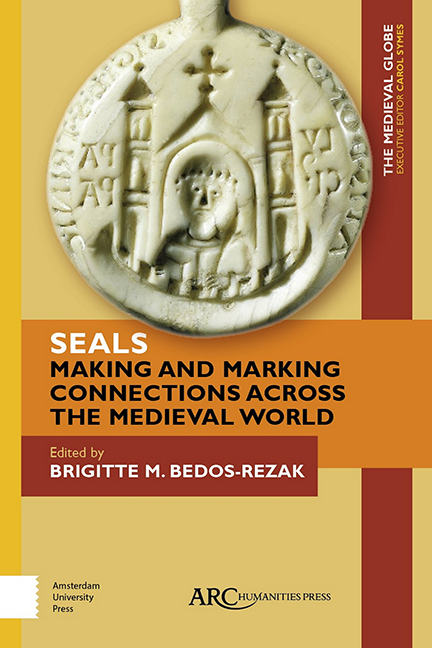Book contents
- Frontmatter
- Contents
- List of Illustrations
- Acknowledgements
- Cultural Transactions: An Introduction to Medieval Seals from a Global Perspective
- Seals as Conceptual and Ritual Tools in Chinese Buddhism, ca. 600– 1000 CE
- Imprinting Powers: The Astrological Seal and Its Doctrinal Meanings in the Latin West
- A Medieval Solution to an Early Modern Problem? The Royal Animal Seals of Jambi
- Expressing New Rule: Seals from Early Islamic Egypt and Syria, 600– 800 CE
- The Formulation of Urban Identity on Byzantine Seals
- The Cloth Seal: A Mark of Quality, Identification, or Taxation?
- Archaeology and Sigillography in Northern Europe
- Medieval Treaties and the Diplomatic Aesthetic
- Index
A Medieval Solution to an Early Modern Problem? The Royal Animal Seals of Jambi
Published online by Cambridge University Press: 20 November 2020
- Frontmatter
- Contents
- List of Illustrations
- Acknowledgements
- Cultural Transactions: An Introduction to Medieval Seals from a Global Perspective
- Seals as Conceptual and Ritual Tools in Chinese Buddhism, ca. 600– 1000 CE
- Imprinting Powers: The Astrological Seal and Its Doctrinal Meanings in the Latin West
- A Medieval Solution to an Early Modern Problem? The Royal Animal Seals of Jambi
- Expressing New Rule: Seals from Early Islamic Egypt and Syria, 600– 800 CE
- The Formulation of Urban Identity on Byzantine Seals
- The Cloth Seal: A Mark of Quality, Identification, or Taxation?
- Archaeology and Sigillography in Northern Europe
- Medieval Treaties and the Diplomatic Aesthetic
- Index
Summary
Seals in Early Maritime Southeast Asia
They write with Sanscrit-characters and the king uses his ring as a seal. From the description of San Fo-qi (Srivijaya) in the Song-shi, the official history of the Song dynasty (960– 1279)
Srivijaya was a city state on the eastern seaboard of Sumatra, initially centred at Palembang and latterly at Jambi, which exercised enormous political and economic influence over large swathes of maritime Southeast Asia from the seventh to the fourteenth centuries (see Map 4.1). While the waxing power of Srivijaya coincided with the medieval era in Europe, its waning moved the Malay world towards early modern times, characterized by the Islamization of formerly Hindu/ Buddhist royal courts throughout the archipelago from the late thirteenth century onwards, by heightened contact with China through the Ming voyages of exploration in the fifteenth century, and by the arrival of Europeans in Southeast Asia in the early sixteenth century.
Despite its apparently impressive spatial and temporal reach, Srivijaya remains a shadowy entity, its very existence proposed only in the early twentieth century based upon Chinese accounts of a kingdom called “San Fo-qi” and the deciphering of stone inscriptions in Old Malay. It has left few physical remains, and our knowledge of its sigillography is likewise limited to the oft-quoted statement above. Indeed, a survey of the early use of seals throughout maritime Southeast Asia during this medieval period yields but a fragmentary picture, comprising a few imported seal stones engraved with Indic or Arabic script and slightly larger numbers of locally manufactured gold seal rings. It is only in Java that a large enough body of evidence exists (in the form of intaglios, gold signet rings, terracotta and clay sealings, and inscriptional references to seals) to posit a continuous tradition of sealing from the ninth century onwards, even though we still have little understanding of how this may have worked.
From the mid-sixteenth century onwards, however, the evolution of a coherent sealing culture throughout the Islamic courts of the Malay Archipelago can be discerned. The number of Malay seals— understood as seals with inscriptions in Arabic script from Southeast Asia— swells in the course of the seventeenth century, and by the eighteenth and nineteenth centuries constitutes a considerable and developed corpus of over 2,000 seals, documented primarily from impressions on manuscript documents, but including some 300 seal matrices.
- Type
- Chapter
- Information
- Publisher: Amsterdam University PressPrint publication year: 2019



